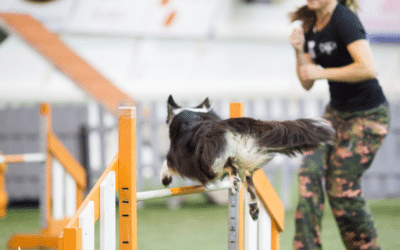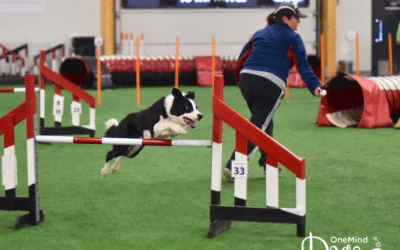No matter what dog activities you like to share with your pup, warm-ups and cooldowns are essential to their health and safety. Keeping your dog in tip-top shape requires a training plan. Just like human athletes need a regime, dog sports athletes also need to get their heads in the game with routine exercise.
Before any competition or training session, these warm-ups and cooldown activities can help your dog perform and recover better while lowering their risk of injury.
Why Warm-Ups Matter
Warm up exercises for dogs help canines avoid muscle strain, tears, and other sports-related injuries. Warm-ups also safely elevate heart rates and breathing, boosting blood circulation to major organs that will need more oxygen during your dog’s workout.
Another major advantage of warm-ups is that they help your dog mentally shift into a more focused state. Imagine if you were going to play a game of volleyball on the beach. You’d want to spend some time stretching, tossing the ball, and practicing your serves. You certainly wouldn’t give your best game if your friend just threw the ball at you, and then got frustrated when you didn’t hit it over the net.
Before You Get Started
Before you warm up together, it’s important to know your dog’s body well so you can spot any signs of trouble. OneMind Dog’s coach Mari Kaplas suggests focusing on three areas:
- Stretching
- Movement
- Behavior
A dog that over-stretches, stretched more or less than usual or avoids stretching certain muscle groups may have an injury or be dealing with soreness. As far as movement goes, favoring one side of the body over the other or a change in gait is a sign that your pup might be hurt. A healthy dog should always trot (opposite legs moving at the same time) rather than pace (both legs on one side of the body move together at once).
And lastly, behavior. Behavior is the clearest indicator of how our dogs are feeling. When your normally happy-go-lucky dog suddenly snaps or acts aggressive, they are likely in pain. They could also appear withdrawn or stop obeying any commands.
2 Key Warm-up Exercises for Dog Sports
Whether you’re new to agility training or have been at it for years, there are two exercises we suggest incorporating into your warm-up regime.
Jogging
Jogging next to you on the lead for 10 to 15 minutes helps your dog’s body warm up and get ready for more intense movements later. Start off walking, then pick up the pace. Slow down for a few minutes, then accelerate again. Make sure you also turn directions multiple times to ensure both sides of your pup’s body are given enough of a stretch during this exercise. If your dog hasn’t done this before, reward them next to you regularly while you are moving together.
Dog activities require near-perfect coordination, so trainers have to ensure their warm-up routines fully stretch and lengthen muscles and ligaments that the dog will be using during their chosen sport.
Massage
A warm-up massage can help increase blood flow and improve flexibility during dog sports or other activities. Gently massage your dog’s neck, shoulders, back, and the large muscle groups on their hind legs. If you aren’t sure where to massage, ask your vet or a canine physiotherapist.
OneMind Dogs coaches are also happy to answer any questions you have, just contact us here.
Onto Active Stretches
After you’ve warmed up, it’s time to dive into active stretching. Make sure that you only do this after your dog has adequately prepared for activities. One mistake many new trainers make is using these active stretch techniques as their warm-up. While they are part of a balanced routine, they should only come after the dog has activated its muscles and prepared for more intense movements.
Some active stretches you might do include:
- Weaving between your legs
- Tugging side-to-side on a rope toy (not up and down as this can injure the neck!)
- Spinning left and right
- Changing positions (from sitting to standing, for example)
- Backing up
- Being sent around an object
Once your dog is warmed up, make sure you get straight into your training. Avoid any delays that will cause them to cool down again or lose focus. You want to send the message that this is your time together. You’re here for them, so they can show up for you.
Critical Cooldowns: What You Need to Know
Cooldowns can prevent injury, soreness, and post-exercise strain in dogs and people. Just like you need to safely bring your heart rate down to a normal level, so does your pup. When you’ve finished exercising or training, take another light jog for 10 to 15 minutes which ends in a slow walk.
Afterwards, you can engage in passive stretches. With your dog standing, gently lift and extend their limbs. Hold each leg extended for 10 to 20 seconds. If your dog squirms or shows any signs of discomfort, stop. Remember, always listen to their body, and trust their signals. If you’re not comfortable stretching your dog, ask your vet or canine physio to demonstrate for you.
If you notice any signs of discomfort during any activity, stop and assess. Are you pushing them too hard? Do they seem to only avoid a particular obstacle that could indicate an area of discomfort?
One of the biggest reasons dogs experience sports injuries is that their handlers missed important signs something wasn’t right.
The importance of resting your dog
A valuable and vital part of preventing injuries and ensuring your sports dog stays in tip-top shape is ensuring they are well-rested between activities and training. There are several ways to help your dog recover more quickly between activities. For example, the latest advancement in the canine magnetic therapy market provides sports dogs with a technology suitable for use directly after exercise as no heat in generated by its revolutionary approach.
This new addition to the magnetic therapy market has become a popular product within the dog agility community and has the backing of some top-named dog agility handlers in the sport both for the ongoing support of their dogs and to support any injuries that may occur. Other treatments and therapies which are widely used to support dogs’ ongoing health are hydrotherapy sessions, massage and physiotherapy – all of which are designed to support the dogs’ ongoing rehabilitation.
Build a Bond That Keeps Them Safe
Warm-ups and cooldowns have the added benefit of helping you learn to communicate with your dog even more. You have to trust your pup as much as you need them to trust you on the field. One of the easiest ways to improve communication and connection with your dog is to work together and understand each other’s languages.
Both warm-ups and cooldowns act as cues for your dog. They let them know when it’s time to prepare for an activity, as well as when they can start to ease their focus and go back to their normal routine.
At the end of the day, what matters most is that your dog is having fun. Even if they don’t wind up becoming a champion in sports, agility and other dog sports can be an activity that brings you two closer together.
Fill out a form and download a free infographic with warm up and cool down exercises:



